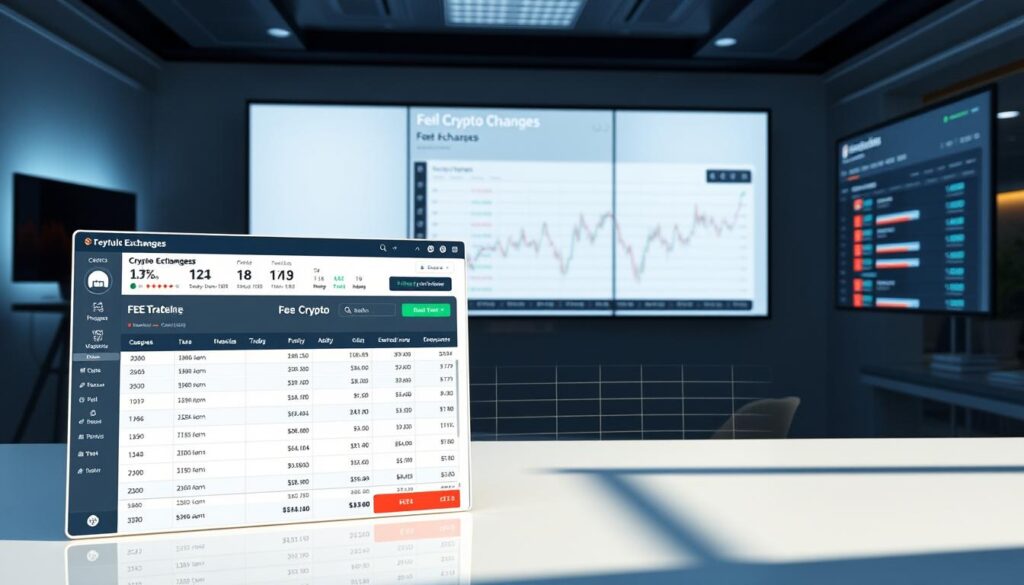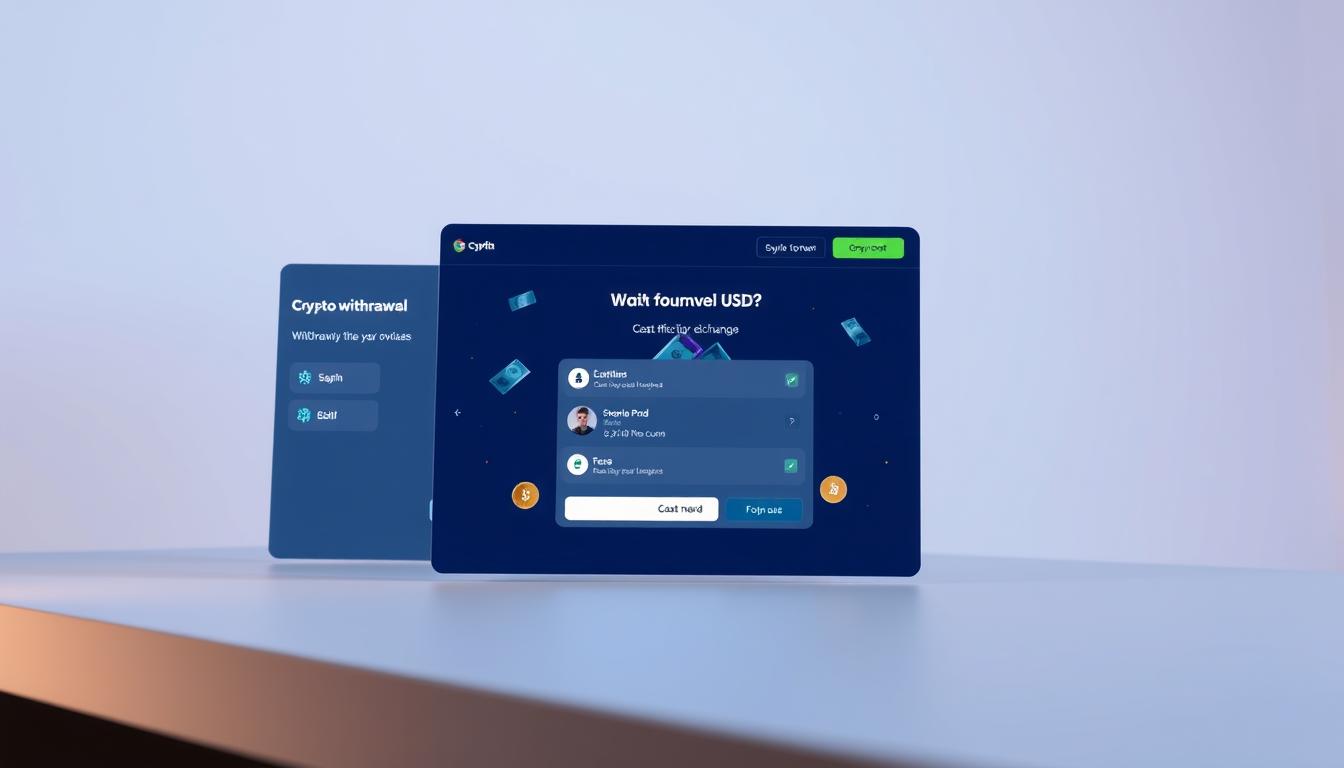Now Reading: Best Crypto Exchange for Day Trading Low Fees Reviewed
- 01
Best Crypto Exchange for Day Trading Low Fees Reviewed
Best Crypto Exchange for Day Trading Low Fees Reviewed

Active traders seeking to maximize returns understand that transaction expenses play a huge role. Every trade executed throughout a session adds up, directly affecting the bottom line. This makes selecting the right platform a critical first step.
Our analysis focuses on services available to traders in the United States. We examine which providers offer the most competitive pricing models. The goal is to identify environments that support high-volume strategies without excessive costs.
We evaluated numerous factors beyond just the advertised rates. Liquidity, execution speed, and advanced order types are equally vital for success. This comprehensive review combines expert data and user experiences for a clear picture.
Key Takeaways
- Transaction costs accumulate quickly and can significantly impact profitability for active participants.
- The most suitable platforms combine low-cost structures with high liquidity and fast trade execution.
- Features like volume-based discounts and native token benefits can lead to substantial savings.
- This review assesses both dedicated digital asset marketplaces and traditional brokers offering these services.
- Understanding the fine details of a fee schedule is essential for long-term trading success.
Introduction
Successful short-term market participants recognize that the right environment can significantly impact their operational efficiency. This analysis focuses on identifying marketplaces that support frequent transaction activity while maintaining cost-effectiveness.
Purpose of the Review
Our objective is to deliver comprehensive, data-driven insights about digital asset marketplaces with competitive pricing models. We examine how different services accommodate high-volume strategies.
The evaluation covers multiple dimensions beyond simple fee structures. We assess execution speed, liquidity depth, and specialized order types that active participants require.
What to Expect from This Listicle
Readers will find detailed examinations of each marketplace’s pricing model. This includes maker/taker fee breakdowns and volume-based discount programs.
Our methodology combines quantitative data with qualitative feedback from actual participants. Each assessment covers supported asset pairs and advanced charting tools.
By the conclusion, users will have sufficient information to select services aligning with their specific operational requirements and risk parameters.
Understanding Crypto Exchanges: How They Operate
The infrastructure supporting cryptocurrency transactions relies heavily on specialized platforms that connect buyers and sellers. These venues serve as critical intermediaries in the digital asset ecosystem.
Definition and Role in the Crypto Market
A cryptocurrency marketplace functions as a digital venue where users can convert traditional currency into digital assets. These platforms also facilitate swaps between different cryptocurrencies.
The role of these marketplaces extends beyond simple transaction facilitation. They provide price discovery mechanisms and maintain market liquidity. This infrastructure supports the entire digital asset ecosystem.
Centralized vs. Decentralized Exchanges
Centralized platforms operate under company management that controls user funds and order matching. These services typically offer higher liquidity and faster execution speeds.
Decentralized alternatives use blockchain technology for peer-to-peer transactions without central control. While often featuring lower costs, they require more technical knowledge from users.
For active market participants, centralized venues generally provide superior tools and tighter spreads. The choice between platform types depends on individual preferences for control versus convenience.
What is a Crypto Exchange?
At its core, a digital asset marketplace provides the essential infrastructure for converting traditional money into cryptocurrencies. It acts as a bridge between the conventional financial system and the world of digital currencies.
These platforms function as intermediaries. They connect buyers and sellers, providing the security and technology needed for safe transactions.
A key component is the order book. This tool displays all current buy and sell orders, showing market liquidity at various price points. This transparency helps traders make informed decisions.
Modern services offer much more than simple trading. They include features like margin trading, futures, and staking programs. These advanced options cater to diverse user strategies.
Every platform has unique characteristics. These differences include supported assets, fee models, and geographic availability. Choosing the right one is crucial for success.
For active participants, the selection significantly impacts costs and execution speed. A thorough understanding of these marketplaces is the first step. You can find detailed assessments in comprehensive platform reviews.
Benefits of Using Crypto Exchanges for Day Trading
Operational efficiency reaches new heights when market participants leverage platforms built specifically for high-frequency activity. These specialized venues offer distinct advantages that support successful short-term strategies.

Marketplaces designed for active participants provide tools and structures that enhance profitability. The combination of competitive pricing and robust infrastructure creates an environment conducive to frequent transaction execution.
Low Fees and High Trading Volume
Cost structures play a critical role in determining net returns. Multiple transactions throughout a session can accumulate substantial expenses without proper fee management.
Platforms with significant user activity ensure deep liquidity pools. This minimizes price slippage when entering or exiting positions. Volume-based discount tiers reward participants who maintain higher 30-day trading volume with progressively reduced costs.
Advanced order types enable precise execution strategies while controlling expenses. Limit orders and conditional options help manage transaction costs effectively.
Comprehensive marketplaces offer numerous digital asset pairs. This allows capitalizing on price movements across different cryptocurrencies without maintaining multiple accounts. The large user bases of established platforms ensure accurate price discovery mechanisms.
Additional advantages include real-time data feeds, professional charting tools, and API connectivity. These resources support automated strategies and technical analysis refinement.
An Overview of the Best Crypto Exchange for Day Trading Low Fees
The landscape of digital asset trading platforms offers diverse options for cost-conscious participants. Marketplaces vary significantly in their fee models and specialized features.
Binance sets a strong standard with 0.10% maker/taker fees across 400+ digital assets. The platform provides additional savings through BNB token discounts and extensive trading pairs.
MEXC stands out with its aggressive pricing structure. This service charges 0.00% for makers and only 0.05% for takers while supporting thousands of cryptocurrencies.
Several platforms match competitive rates while adding unique functionality:
- Pionex includes 16 trading bots at no extra cost with 0.05% fees
- Kraken Pro offers institutional-grade tools with 0.16%/0.26% fee rates
- Bybit and KuCoin provide automated tools alongside 0.10% standard charges
Volume-based discount programs reward active participants across most services. Higher monthly trading activity qualifies users for progressively reduced transaction costs.
These marketplaces combine affordable structures with the liquidity and tools necessary for successful strategies. The right selection depends on individual preference for specific features alongside cost considerations.
Comparative Analysis of Top Crypto Trading Platforms
Industry ratings from reputable sources offer objective assessments of various trading environments. These evaluations help users identify services that match their specific needs.

Examining NerdWallet and Industry Ratings
NerdWallet’s comprehensive methodology evaluates digital asset marketplaces across more than 20 factors. Their process includes detailed questionnaires and hands-on testing.
The ratings provide valuable insights into fee structures and user experience. Uphold leads with a 4.8/5 rating, praised for educational resources.
| Platform | NerdWallet Rating | Fee Range | Key Feature |
|---|---|---|---|
| Uphold | 4.8/5 | 0.2%-2.95% | Strong staking programs |
| Coinbase | 4.6/5 | 0%-4% | 200+ digital assets |
| Gemini | 4.3/5 | 0.03%-3.49% | ActiveTrader platform |
| Crypto.com | Not rated | 0%-2.99% | Cash transfer discounts |
Key Differentiators Among Platforms
Specialized marketplaces typically support hundreds of digital assets. Traditional brokers often limit selection to fewer than ten coins.
Fee structures vary significantly across different services. Advanced order types and leverage options also differ substantially.
Understanding these distinctions helps users select appropriate trading strategies. The right platform choice impacts overall success.
Review of Major Exchanges for Low Fees and High Volume
Real-world user experiences provide invaluable insights into how different platforms perform under actual trading conditions. These perspectives reveal practical considerations beyond advertised rates.
Insights from User Reviews and Expert Opinions
Marketplace fee structures show dramatic variations. Services like MEXC offer 0.00% maker fees while others charge 0.25% or more. This difference significantly impacts profitability for active participants.
Binance maintains popularity with 0.10% standard rates and extensive digital asset support. The platform’s volume-based discounts reduce costs substantially for high-frequency users.
Transparency emerges as a consistent concern in user feedback. Some services receive criticism for complicated pricing models that change based on transaction methods. Others earn praise for clear, predictable fee schedules.
Experts emphasize that cost considerations must balance with other factors. Liquidity depth and execution reliability often justify slightly higher expenses on established platforms. These elements prevent slippage during rapid position changes.
Volume-based discount programs benefit active market participants significantly. Many services reduce costs by 50% or more for users maintaining substantial monthly activity. This reward system makes frequent trading more sustainable.
Key Features of Leading Crypto Trading Platforms
The competitive edge of top trading services lies in their ability to provide integrated solutions that cater to various user needs simultaneously. Modern marketplaces have evolved into comprehensive ecosystems.
These environments combine multiple functionalities beyond basic transaction execution. They create value through diverse tools and services.
Trading Tools, Staking, and Wallet Options
Automated trading represents a significant advancement for active participants. Services like Pionex offer 16 free bots while Bybit provides 12 different automated options.
These tools execute strategies based on predetermined parameters. They help users capitalize on market movements around the clock.
Staking services enable earning passive yields on digital assets. Platforms like Binance and KuCoin offer annual returns between 5% and 23% on supported cryptocurrencies.
Wallet integration has become standard across major services. Users can choose between hot wallets for active trading and cold storage for long-term security.
Advanced order types give experienced traders precise control. Options include iceberg orders and fill-or-kill executions for strategic positioning.
Additional features like launchpads and payment cards create complete ecosystems. They serve diverse needs beyond pure trading activities.
Day Trading Strategies for Cryptocurrencies
Mastering the art of quick position changes in volatile markets demands specific tactical knowledge. This approach involves opening and closing positions within the same session to capture intraday price movements.
Successful participants execute multiple trades daily, focusing on short-term fluctuations rather than long-term holdings. They identify assets with sufficient liquidity and volatility to create profitable opportunities.
Short-Term Trading Techniques
Several approaches help traders capitalize on market movements. Scalping targets small price changes with high-frequency activity. Momentum strategies follow strong directional trends.
Range trading works well in sideways markets, buying at support levels and selling at resistance. Each method requires different skills and risk tolerance levels.
| Trading Approach | Typical Timeframe | Key Focus |
|---|---|---|
| Scalping | 1-5 minutes | Small, frequent gains |
| Momentum | 15-60 minutes | Trend identification |
| Range Trading | 30 minutes-4 hours | Support/resistance levels |
Risk Management and Technical Analysis
Technical analysis forms the foundation of most strategies. Traders use chart patterns, trend lines, and indicators like RSI and MACD. These tools help identify optimal entry and exit points.
Risk management becomes critical due to frequent trading activity. Position sizing, stop-loss orders, and daily loss limits protect capital. The 24/7 nature of cryptocurrency markets requires discipline to avoid overtrading.
Evaluating Trading Fees and Incentives
The financial impact of transaction costs accumulates rapidly for users maintaining high-frequency activity levels. Careful examination of pricing structures becomes essential for sustainable participation.

Understanding the distinction between maker and taker fees is fundamental. Makers add liquidity to order books, while takers remove it. Most platforms charge lower rates for makers to encourage market depth.
Fee Structures Across Different Exchanges
Pricing models show dramatic variations across services. Some charge 0.00% for makers, while others exceed 3.99% for certain transactions. The payment method also influences final costs significantly.
Volume-based discount programs reward active participants. Higher 30-day trading volume qualifies users for progressively reduced rates. These tiered structures typically span five to ten levels.
Native token incentives provide additional savings opportunities. Platforms offer 20-25% discounts when users pay using their proprietary tokens. This creates loyalty while reducing operational expenses.
Hidden charges require careful scrutiny. Withdrawal fees, deposit costs, and currency conversion markups can substantially increase total expenses beyond advertised rates.
For frequent participants, even small fee differences translate to substantial annual savings. Selecting the right platform based on comprehensive cost analysis becomes a critical profitability factor.
User Experience and Interface Considerations
The learning curve for market participation varies dramatically based on platform design choices. Services must accommodate both newcomers and experienced participants through thoughtful interface development.
Navigation intuitiveness and tool accessibility directly impact how quickly users can achieve their objectives. Well-designed environments reduce frustration and improve operational efficiency.
Ease of Use for Beginners
Several services prioritize simplicity for those starting their journey. Coinbase stands out with educational resources through its Coinbase Earn program.
Gemini offers a standard interface that casual investors find straightforward. Pionex provides user-friendly automation tools for beginners wanting bot-assisted strategies.
Practice environments like Phemex’s Virtual Mock Trading allow skill development without financial risk. These demo accounts help newcomers build confidence before using real capital.
Advanced Interface Features for Pros
Experienced participants require sophisticated tools for complex strategies. Customizable chart layouts with multiple technical indicators support detailed analysis.
Platforms like Kraken offer separate Simple and Pro account types. This multi-tier approach lets users graduate to advanced features as their skills evolve.
Real-time market depth displays and advanced order panels enable precise execution. Mobile applications replicate desktop functionality for trading on the move.
Account access requirements range from simple email registration to comprehensive verification processes. Customer support availability varies significantly across different services.
Security, Support, and Compliance Overview
Protecting digital assets requires robust security protocols that reputable platforms implement. These measures build user confidence and prevent potential financial losses.

Gemini sets the industry standard with comprehensive protection systems. The platform undergoes regular third-party audits including SOC 1/SOC 2 Type 2 exams. It also maintains ISO 27001 certification for information security management.
Two-factor authentication has become essential across all quality services. This requires secondary device verification during login and withdrawal processes. Hardware security keys like YubiKey provide additional protection layers.
Cold storage protocols keep 90-98% of customer assets offline. This prevents hacking attempts that target internet-connected wallets. Insurance coverage varies significantly between different marketplaces.
| Platform | Security Certifications | Storage Method | Insurance Coverage |
|---|---|---|---|
| Gemini | SOC 1/SOC 2, ISO 27001 | 95% cold storage | FDIC + crypto insurance |
| Standard Platform | Basic compliance | Mixed cold/hot storage | Limited protection |
| Basic Service | Minimal verification | Primarily hot wallets | No insurance |
Customer support quality impacts experience substantially. Traditional brokers often offer phone assistance while digital-focused services rely on ticket systems. Response times can vary from minutes to days.
Regulatory compliance demonstrates platform legitimacy. Services operating under frameworks like New York’s BitLicense show stronger commitment to legal standards. Users should verify licensing status before committing funds.
Account holders bear ultimate responsibility for their security. Strong passwords and enabled security features provide essential protection. Understanding that individual compromises typically aren’t covered by exchange policies is crucial.
Advanced Trading Tools for Experienced Traders
Sophisticated traders demand more than simple buy/sell options from their chosen marketplace. Professional-grade platforms offer comprehensive toolkits that enhance analytical capabilities and execution precision.
Charting, Order Types, and Automated Trading
Advanced charting packages provide multi-timeframe analysis with over 100 technical indicators. These tools help identify patterns and optimize strategy development.
Complex order types extend beyond basic market and limit orders. Options include iceberg orders, post-only executions, and conditional triggers based on price movements.
Automated functionality eliminates constant market monitoring. Pionex offers 16 free bots for strategies like grid trading and dollar-cost averaging. Bybit provides 12 different automated options including copy trading features.
Special Features Like ActiveTrader and Web3 Integration
Gemini’s ActiveTrader platform delivers execution speeds of 65 microseconds. It supports futures and perpetual contracts alongside professional charting tools.
Web3 integration opens decentralized finance opportunities. Binance’s Web3 Wallet and similar features provide access to yield farming and early token launches.
API connectivity enables custom algorithmic strategies. This allows experienced participants to implement high-frequency execution based on complex quantitative models.
How to Get Started with Cryptocurrency Trading
The first practical step toward participating in cryptocurrency markets involves establishing a trading account. This process varies across different platforms but follows a general pattern that new users can navigate efficiently.
Setting Up an Account
Selecting the right platform requires careful consideration of fee structures and available features. Different services cater to various trading styles and experience levels.
The registration process typically begins with email verification and password creation. Most platforms complete initial setup within minutes. Users then progress to identity verification steps.
Know Your Customer requirements represent a critical security measure. These procedures involve submitting government-issued identification and proof of address. Verification timelines range from immediate to several days.
Funding options include bank transfers, card payments, and digital currency deposits. Each method carries different processing times and potential fees. Most platforms impose no minimum deposit requirements, allowing small initial investments.
New participants should begin with major digital assets like Bitcoin and Ethereum. These cryptocurrencies offer high liquidity and stable market conditions. Demo accounts provide valuable practice before committing real capital.
Future Trends in Crypto Trading and Exchange Platforms
The digital asset landscape continues evolving with institutional adoption reshaping market dynamics. Bitcoin reached new highs in October, while Ethereum surged in August 2025. Both benefited from spot Bitcoin ETFs and stablecoin legislation.
Regulatory clarity in major markets like the United States accelerates institutional participation. This increases liquidity while creating standardized compliance requirements. The integration of traditional financial products bridges gaps between conventional and digital markets.
Ethereum’s evolution drives growth in tokenized traditional financial assets. These include lending platforms, stock trading, and real estate. The scope of tradable cryptocurrency assets expands beyond pure digital currencies.
Artificial intelligence and machine learning enhance platform capabilities. Predictive algorithms and automated strategy optimization become standard features. These tools provide personalized recommendations based on user behavior patterns.
| Emerging Trend | Market Impact | Timeline |
|---|---|---|
| DeFi Integration | Seamless yield farming access | Current-2026 |
| Cross-chain Solutions | Reduced fragmentation | 2025-2027 |
| Enhanced Security | Biometric authentication | Ongoing |
| Web3 Convergence | Unified digital asset hubs | 2026+ |
Decentralized finance integration represents a continuing trend. Platforms offer transitions between centralized trading and DeFi protocols. Cross-chain functionality reduces market fragmentation across blockchain networks.
Enhanced security measures become standard as institutional capital increases. These include biometric authentication and decentralized custody solutions. The convergence of Web3 technologies creates comprehensive digital asset ecosystems.
Conclusion
As we conclude this comprehensive analysis, the importance of matching platform capabilities with personal trading strategies becomes clear. The selection process involves balancing multiple factors beyond just transaction costs.
Different platforms cater to various priorities. Some focus on ultra-competitive pricing structures, while others emphasize security and regulatory compliance. Your choice should align with your specific needs and experience level.
Successful market participation extends beyond platform selection. It requires developing sound technical skills and implementing disciplined risk management. Continuous learning and strategy adaptation remain essential for long-term success.
New participants should begin with thorough research and small positions. As confidence grows, they can explore more advanced tools and features. The evolving digital asset landscape promises continued innovation in trading infrastructure.
FAQ
What makes a trading platform suitable for day trading?
A platform ideal for this strategy typically offers robust charting tools, real-time data, and a variety of order types. Low transaction costs are crucial because frequent trades can quickly accumulate fees. High liquidity ensures you can enter and exit positions at desired prices without significant slippage.
How do fee structures vary among different platforms?
Fee models differ significantly. Some services use a maker-taker system, rewarding users who add liquidity to the order book. Others charge a flat percentage per trade. It’s vital to review each platform’s schedule, as costs can decrease with higher 30-day trading volume or holding the platform’s native asset.
Are decentralized exchanges a good option for active traders?
While decentralized platforms offer greater control over assets, they often lack the advanced tools and speed required for effective day trading. Centralized exchanges usually provide the necessary infrastructure, including advanced interfaces and customer support, making them more suitable for high-frequency strategies.
What security features should I look for in an exchange?
Prioritize platforms that offer strong safeguards like two-factor authentication (2FA), cold storage for the majority of digital assets, and insurance funds. Regulatory compliance and a transparent track record on security are also key indicators of a trustworthy service.
Can beginners effectively use platforms designed for experienced traders?
Many leading platforms now offer tiered experiences. They may have a simple, intuitive mode for buying and selling, alongside a more advanced interface with professional charting and order books. This allows new investors to start simply and gradually access more complex tools as their knowledge grows.
What are the benefits of staking on a trading platform?
Staking allows you to earn rewards on certain cryptocurrencies you hold, effectively generating a passive income. Some services also offer benefits like reduced trading fees for users who stake their native tokens, adding an extra incentive beyond just earning rewards.













